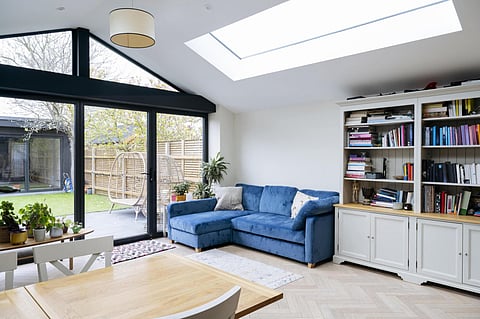Tips to make the most of a small extension
Small extensions have many plus points. They can give you extra space without needing to spend too much time and money on construction. Plus, you can usually build under them under permitted development rules, cutting out stressful planning applications to the council.
Of course, a small extension does have its downsides. Namely, the size. It restricts how much you can cram into it. But there are ways to make a small extension sing. So, here’s some top tips to get the most out of your build.
Keep the ceiling height high
If your footprint is limited, try to get as much head height as possible on your extension to help boost the sense of space. In single-storey extensions you needn’t stick with a flat roof as gable, crown and single sloping roofs are often better for increasing ceiling height.
But where this is tricky, consider a roof lantern or pyramid skylight to gain more headroom. These can be installed for as little as £950, so they needn’t break your budget.
Open out the space
Just because your extension is small, it doesn’t mean you should limit yourself to tiny rooms. By taking down a few of your existing walls, you can really open up the inside of your home to create a big open plan space. And even just a few extra square meters should be enough to turn a small kitchen into a sociable cooking and dining area.
If you are thinking of remodelling your ground floor alongside the extension, it might be wise to hire an architect. They can help you make the most of the space available.
Connect the extension to the garden
As well as going open plan, there are other tricks to make your extension feel bigger. Extending your flooring out into the garden to create a large indoor-outdoor space is one idea. There are plenty of stone and porcelain flooring types that are suitable for indoor and outdoor use, enabling you to create a seamless transition between the two spaces. Adding bifold doors will allow you to fully open out the rear of the extension and complete the connection.
Bifold door costs do vary, depending on the number of doors and the type of frames you go for. But you can expect to pay an average of £3,000. This is around twice what you’d pay for standard sliding doors but to maximise your usable space, it could work out to be your most savvy buy.
There’s no need to stick to brick
Unless there are specific rules you need to stick to – such as those relating to listed buildings and conservation areas – think about incorporating different materials into the build to make your extension stand out.
Fully or partially cladding the extension in wood or metal can produce a modern look that creates a nice juxtaposition with your existing property. And if your extension is a boxy, flat-roofed affair, it’s going to make it look a lot more appealing. Introducing more glazed elements can also give your small extension more of a wow factor. Plus, it maximises the natural light coming in.
Plan everything out
With any extension, there isn’t just the build to plan. You also need to think through the function of your extension and what’s going in it. And you’re wise to do this right from the start. This not only ensures the extension goes in the right position, but that it’s the right size and shape for its function.
You need to think about the layout of your fixtures and fittings. For example, if you’re planning a kitchen with an island, then map out where everything will go before you start construction. Is the space adequate to fit in all your units and still give you plenty of room to move around?
Consider colour
One cost-effective way you can really enhance the interior of a small extension is to use colour. Bright white can make even the smallest space feel airy.
But you needn’t stick to all white to make a big impact. And if your extension is housing a bedroom, snug or other cosy space, then there are other colours that can work much better at adding warmth, such as taupe or blush pink.
If you’re looking to wow, then a more dramatic colour such as a dark green or blue might be just the ticket. But if you’re looking to create the illusion of more space, then you could use vertical stripes on the walls or paint ceilings in a darker shade than the walls to give the impression of height.
Inspired by what you read?
Get more stories like this—plus exclusive guides and resident recommendations—delivered to your inbox. Subscribe to our exclusive newsletter
Resident may include affiliate links or sponsored content in our features. These partnerships support our publication and allow us to continue sharing stories and recommendations with our readers.

